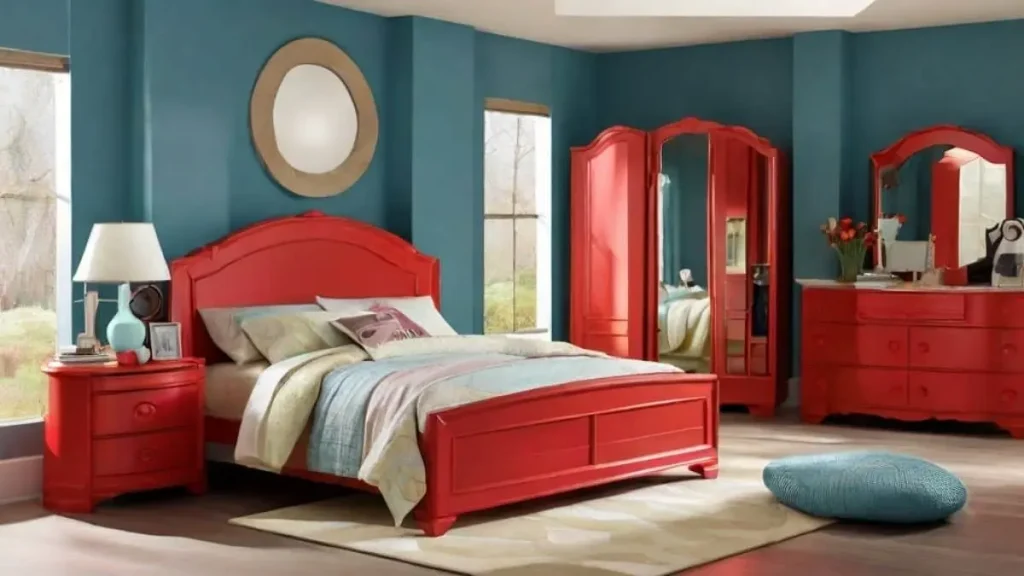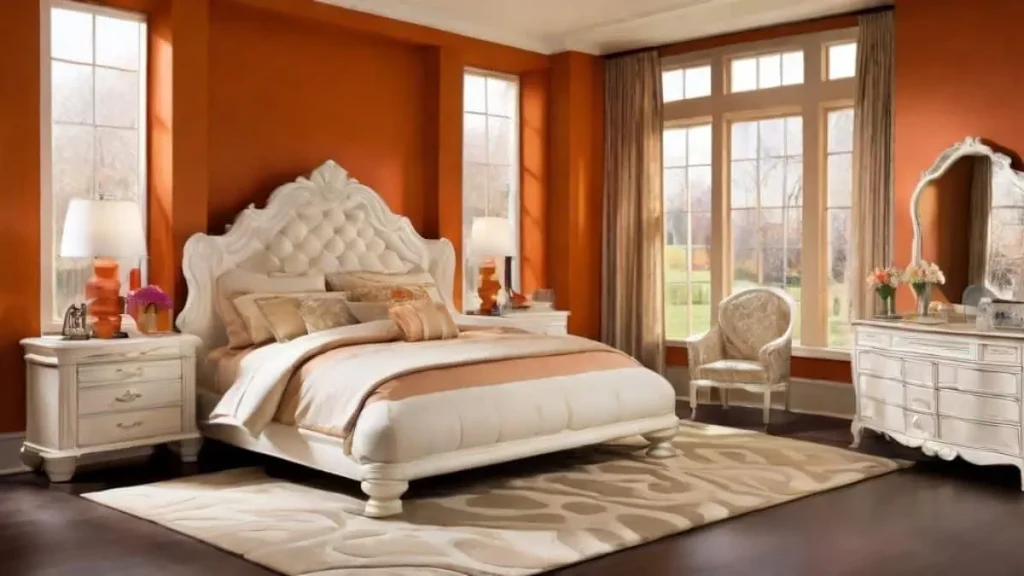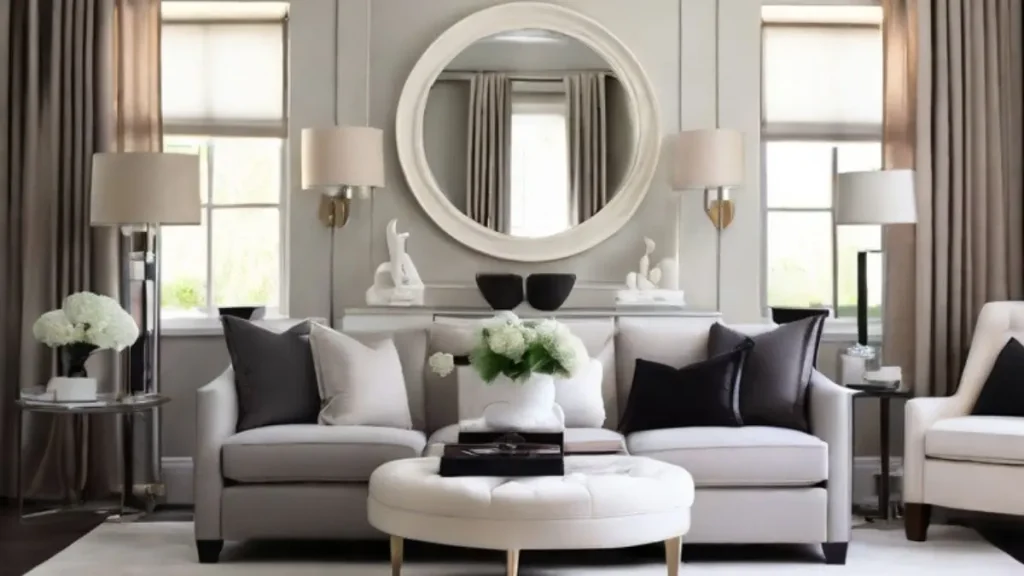Choosing the perfect bedroom color scheme is more than just a design choice; it’s about creating a space that feels like home. Your bedroom is where you start and end your day, so the colors you choose can have a big impact on how relaxed and refreshed you feel.
Whether you’re aiming for a calm retreat or a vibrant and energizing space, the right color scheme can make all the difference.
From understanding how colors affect your mood to practical tips for picking the right shades, we’ll cover it all. By the end of this post, you’ll have the confidence to choose colors that not only look great but also enhance your overall well-being.
Know the Color Psychology
What is Color Psychology?
Color psychology is the study of how colors influence human behavior and emotions. It’s no secret that colors can evoke certain feelings—think about how a bright yellow room can make you feel cheerful, while a deep blue can have a calming effect. Understanding the basics of color psychology can help you choose bedroom colors that create the atmosphere you want.
Impact of Colors on Sleep and Relaxation
When it comes to bedrooms, the colors you choose can either promote relaxation or disrupt your sleep. For example, shades of blue and green are known for their calming properties, making them ideal for a peaceful bedroom environment. These colors are often associated with nature, helping to create a serene atmosphere that can ease your mind after a long day.
On the other hand, bold colors like red or bright yellow can be stimulating. While they might work well as accent colors, using them as the dominant color in your bedroom might make it harder to unwind.
Choosing Colors Based on Desired Mood
Before you pick a color, think about the mood you want to create in your bedroom. Do you want it to be a restful retreat where you can relax and recharge? Soft, muted colors like lavender, soft gray, or pale blue might be the way to go. If you’re looking for a space that energizes you, consider incorporating brighter, more vibrant hues like coral or sunny yellow in moderation.
Practical Tips for Selecting Bedroom Colors

Assessing Room Size and Lighting
The size of your bedroom and the amount of natural light it receives are key factors in choosing the right color scheme. In smaller rooms, lighter colors can help create the illusion of more space, making the room feel airy and open. Shades like soft white, light gray, or pale blue can reflect more light and make a compact bedroom feel less confined.
If your bedroom gets plenty of natural light, you have more flexibility in your color choices. However, rooms with limited natural light might benefit from warmer tones to add coziness. In darker rooms, avoid overly dark colors that could make the space feel even more enclosed.
Complementary Colors and Accent Walls
One effective way to add interest to your bedroom is by using complementary colors—colors that are opposite each other on the color wheel. For example, a soft blue paired with a warm orange can create a balanced, visually appealing look. This approach works well when you want to introduce a pop of color without overwhelming the space.
Accent walls are another great way to experiment with bold colors. By painting just one wall in a vibrant hue, like deep teal or rich burgundy, you can create a focal point in the room while keeping the overall look cohesive. The other walls can remain neutral to balance the intensity of the accent color.
Considering Existing Furniture and Décor
Your bedroom’s existing furniture and décor play a significant role in determining the best color scheme. If you have a lot of wooden furniture, for instance, you might want to choose colors that complement the natural tones of the wood. Warm colors like soft browns, creams, or earthy greens can enhance the organic feel of the space.
If your furniture is more modern and minimalistic, cooler tones like gray, navy, or muted pastels can complement the sleek lines and create a cohesive look. Always consider the colors of your bedding, rugs, and accessories when selecting your wall colors to ensure everything works together harmoniously.
Testing Paint Samples
Before committing to a color, it’s essential to test paint samples in your bedroom. Paint a small section of the wall and observe how the color looks at different times of the day, under both natural and artificial light.
Colors can appear differently depending on the lighting and surrounding elements, so taking this extra step can save you from making a choice you might regret later.
If you’re unsure about a bold color, start with a lighter shade or use it in smaller doses, such as on an accent wall or in your accessories. This allows you to experiment without overwhelming the space.
Popular Bedroom Color Schemes

Classic Neutrals
Neutrals like white, gray, and beige are timeless choices that never go out of style. These colors provide a clean, calming backdrop that can make your bedroom feel light and spacious. They’re also incredibly versatile, allowing you to change your décor easily without worrying about clashing colors.
- Example: A bedroom with soft gray walls, white bedding, and wooden accents for a modern yet cozy feel.
Bold and Dramatic
If you’re looking to make a statement, consider bold and dramatic colors like deep purples, dark blues, or rich greens. These colors can add a sense of luxury and depth to your bedroom, making it feel more intimate and sophisticated.
- Example: A bedroom with dark navy walls, gold accents, and plush textiles for a luxurious, dramatic vibe.
Soft and Serene
For those who prefer a more tranquil atmosphere, soft pastel colors are the way to go. Shades like light pink, pale blue, or gentle lavender can create a peaceful and soothing environment, perfect for unwinding at the end of the day.
- Example: A bedroom with soft lavender walls, white linens, and silver accents for a serene, dreamy retreat.
Earthy Tones
Earthy colors like terracotta, olive green, and warm browns bring a natural, grounded feel to your bedroom. These colors are particularly well-suited for those who want to create a cozy, rustic environment.
- Example: A bedroom with warm terracotta walls, wooden furniture, and soft beige textiles for a welcoming, earthy feel.
Combining Colors Effectively

Monochromatic Schemes
A monochromatic color scheme involves using different shades, tints, and tones of a single color to create a cohesive and harmonious look. This approach is perfect if you prefer a simple, understated design that still feels elegant and pulled together. For example, varying shades of blue—ranging from a soft sky blue to a deep navy—can give your bedroom depth while maintaining a soothing and unified appearance.
- Practical Tip: Start with a base color, like light gray or pale blue, and layer in darker or lighter variations of that color through your bedding, rugs, and accessories. This technique adds visual interest without overwhelming the space.
Analogous Schemes
An analogous color scheme uses colors that are next to each other on the color wheel, such as blue, green, and teal. These colors naturally complement each other and create a serene, visually pleasing environment. An analogous scheme is ideal if you want a room that feels harmonious but with a bit more variety than a monochromatic approach.
- Practical Tip: Choose one dominant color and use the other analogous colors as accents. For example, if you select green as your main color, you could incorporate shades of blue and teal through throw pillows, artwork, or curtains to enhance the look.
Contrasting Schemes
For those who love bold contrasts, a contrasting color scheme might be the way to go. This involves pairing colors that are opposite each other on the color wheel, such as blue and orange or purple and yellow. Contrasting schemes are dynamic and energizing, perfect for making a strong statement in your bedroom.
- Practical Tip: Use one color as the primary hue and the other as an accent. For instance, if you choose a deep blue for the walls, you could add pops of orange through décor items like a throw blanket or wall art. This approach keeps the room from feeling too intense while still providing that striking contrast.
Final Tips for a Cohesive Look

Using Textures and Patterns
Colors aren’t the only way to add personality to your bedroom—textures and patterns can play a huge role in creating a cohesive and inviting space. For example, if you’ve chosen a neutral color scheme, adding textured elements like a chunky knit throw, a plush rug, or velvet pillows can make the room feel more layered and interesting.
Patterns, when used wisely, can also enhance your color scheme. Stripes, florals, or geometric prints can break up solid colors and add depth to your design. Just be sure to stick to a consistent color palette to avoid clashing patterns.
- Practical Tip: Mix different textures like wood, metal, and soft fabrics to create a rich, tactile experience. When using patterns, start with one bold pattern and complement it with more subtle ones to keep the look balanced.
Balancing Color with Neutral Tones
While it can be fun to play with bold colors, incorporating neutral tones is essential for balance. Neutrals like white, beige, gray, or soft browns can tone down bright colors and provide a calming backdrop for more vibrant accents. This balance ensures that your bedroom feels welcoming and restful, rather than overwhelming.
- Practical Tip: If you have a bold color on the walls, consider using neutral-colored furniture and bedding to balance the look. Alternatively, if your walls are neutral, feel free to experiment with brighter accessories and textiles.
Seasonal Considerations
Your bedroom should be a space you love year-round, but it can be fun to make small adjustments for different seasons. For example, you might want to add warm, rich colors like burgundy or gold in the fall and winter, and switch to lighter, breezier colors like coral or mint in the spring and summer.
- Practical Tip: Instead of repainting your walls with each season, change out smaller items like throw pillows, blankets, and artwork. This way, you can refresh your space without a major overhaul.
Remember, the key to a successful bedroom color scheme is balance—whether it’s through the careful combination of colors, the use of textures and patterns, or the incorporation of seasonal accents.
Conclusion
Choosing the perfect bedroom color scheme is a journey that combines personal taste with the science of color psychology. The right colors can transform your bedroom into a sanctuary—a place where you can relax, recharge, and feel truly at home.
By understanding how colors affect your mood, considering the practical aspects of your space, and thoughtfully combining different shades and tones, you can create a bedroom that not only looks beautiful but also supports your well-being.
Whether you prefer the simplicity of a monochromatic scheme, the harmony of analogous colors, or the drama of contrasting hues, the key is to stay true to what feels right for you.
Don’t be afraid to experiment with different colors, textures, and patterns until you find the perfect balance. And remember, your bedroom is a reflection of you, so let your personality shine through in the choices you make.
With these tips and ideas in mind, you’re well on your way to creating a bedroom color scheme that’s not only stylish but also perfectly suited to your needs. Happy decorating!



